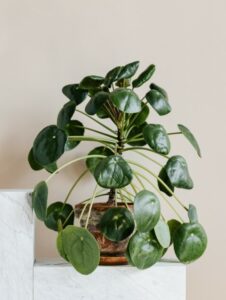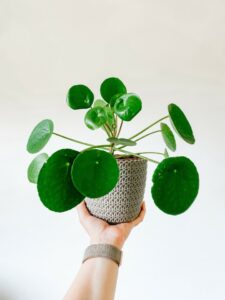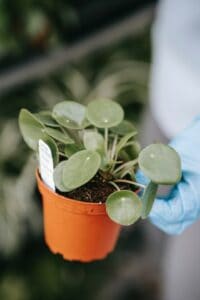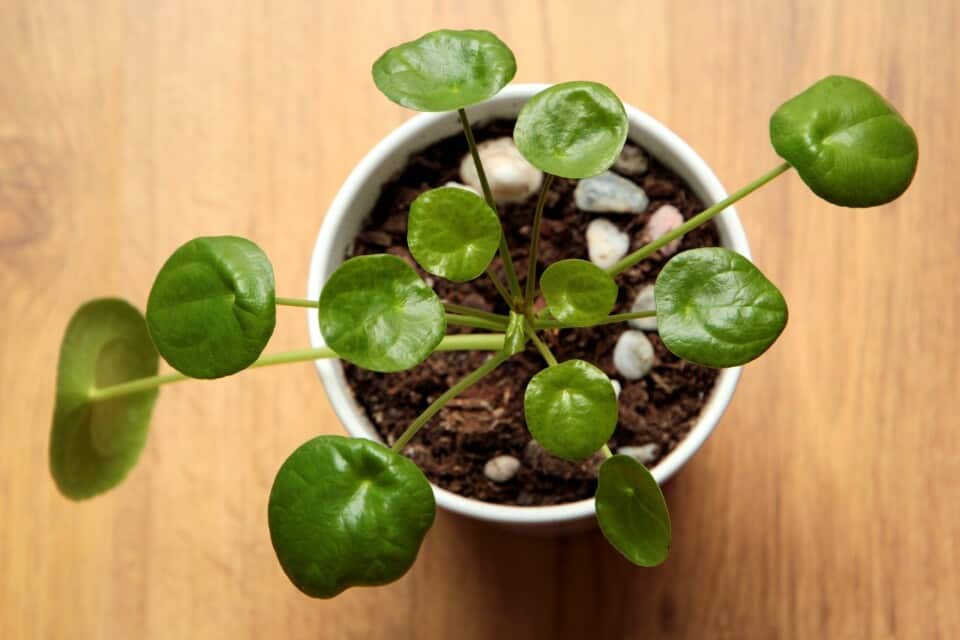Some links in the post are affiliate links and I get a commission from purchases made through some links found in the post.
Whenever I get a new plant, I think of the potting mix, the watering schedule, and the lighting. If you get these three factors right, you will be on a roll.
And anything else you add to the mix (temperature variations, humidity, fertilization, etc.) will be but an addition.
So, when I got my Pilea, I was curious about how well it would fare in my home. I had a few sunny spots, a few gloomy ones, and most of the other sections were bright without good sun exposure. So, which one would work for my Pilea?
It turns out that the Pilea does best in bright and indirect light. And if you leave it in full sun, it burns! To stop your pilea from becoming leggy rotate it 2-3 times a week as your pilea grows towards the sun or light source.
Low light is not good either. But regardless of the light conditions in your home, you can grow a Pilea.
I will break down what the plant needs and how you can accommodate its light requirements without going out of your way. Here goes:
What Type of Light Does My Pilea Need?
Light is essential to the growth of your Pilea as the plant relies on light for photosynthesis. Any Pilea guide will tell you that your plant needs bright and indirect light. But what does this mean? Let’s review the types of lighting:
1) Full Sun
 This light exposure is also known as bright and direct light. It’s where the sun’s rays directly hit the plant foliage.
This light exposure is also known as bright and direct light. It’s where the sun’s rays directly hit the plant foliage.
To achieve this direct sunlight, you should place your plant near a south-facing window.
However, you should note that very few houseplants do well in full sun, which can be scorching. And the Pilea does not thrive in this type of exposure.
2) Partial Sunlight or Partial Shade
This light exposure features bright yet indirect sunlight. As such, the sun’s rays do not directly hit the plant foliage. Yet the light is sufficient to promote photosynthesis.
Under this kind of exposure, the plant gets a few hours of sun during the day. Ideally, this should be morning or evening sun when the rays are gentle.
And to achieve this, you should place the plant near an east-facing or west-facing window where noon or afternoon sunlight cannot reach it. The Pilea does best in this kind of exposure.
3) Low Light
This exposure is also known as full shade. Not many plants can do well in such conditions as it is hard for plants to make food with inadequate access to light.
You can get this kind of exposure from a north-facing window. Please note that a Pilea does not do well in low light conditions. It exhibits leggy growth, and its foliage turns dark green.
4) Artificial Light
Not every home has adequate access to bright and indirect light. But that does not mean that you cannot grow a Pilea.
All you need is to invest in artificial grow lights that supplement the light in your home to keep the Pilea looking healthy with green foliage.
Thus, when you hear of bright and indirect light, what you need is exposure to partial sunlight or partial shade. But that’s not all you need to think about when assessing the type of light. You must also consider:
The Presence of Cold and Hot Drafts
The Pilea does best when kept in temperatures between 60- and 95-degrees Fahrenheit. Anything below this can trigger shock, and anything above this range can hurt the plant. Thus, when positioning the plant towards an east or west-facing window, ensure that you protect it from drafts using sheers.
The Intensity of the Light
How can you tell that the light exposure is bright and indirect? It’s easy! Put your hand three inches away from the wall where the sun enters the room and assess the shadow.
If the light is direct, the shadow cast on the floor will be dark. But if it’s soft, then the light is indirect. However, if there is no shadow cast behind your hand, there is insufficient light in the room. And you thus need to find another spot.
Just like you can use a moisture gauge to assess if your Pilea needs more water, there’s a device you can use to gauge the light intensity in the room. It’s called a light meter.
You can use it to measure the intensity of light in various room spots during the day. Then you can choose the one that consistently receives bright and indirect light for most of the day.
How Much Light Does a Pilea Need?
When growing any plant indoors, the goal is to provide it with what it would get in the outdoors.
If you can replicate its native habitat, you will be one step ahead to giving it what it needs. And with the Pilea, light is not optional.
The plant needs as much light as you can offer it. Availing it such conditions enables it to keep up with its night and day processes, enabling it to make enough food and thrive.
Ideally, the Pilea should receive up to 12 to 16 hours of light. As long as the light is not direct, the plant should be okay.
Of course, achieving 12 hours of bright light may not be feasible in some regions. And in such cases, it’s advisable to use a grow light to supplement the light the plant receives.
You may also like: Why is my pilea drooping?
What Happens If Your Pilea Gets Too Much Light?
If your plant gets too much light, it shows signs of distress in the form of:
- Brittleness and signs of sunburn on the foliage,
- Dark patches on the leaf surface,
- Small yellow spots on the leaves.
These effects result from the heat energy present in the direct sun rays. And the way to fix this is by moving the plant to a spot with bright and indirect light.
Depending on the severity of the sun exposure, the patches on the foliage may fade. But if the effects are permanent, you need to get rid of the affected foliage.
The new growth will not have such spots and will be a replica of what a healthy Pilea should look like.
What Happens If Your Pilea Gets Too Little Light?
The Pilea is quite particular about getting enough light. And when it does not get what it needs, it starts showing signs of distress.
Signs Your Pilea Does Not Get Enough Light
How can you tell that your plant has limited access to light?
1) It has Leggy Growth with Brittle Stems
When plants don’t get the light they need, their stems grow pretty long to help them reach the light.
And because they cannot make enough food to support new foliage, these stems are bare and unsightly. Moreover, the plant stems are weak due to the limited access to food.
We have an article on how to fix a leggy pilea & how to prevent it in the future.
2) It has Small and Weak Leaves
 Generally, Pilea leaves are round and large. But when the plant has limited access to light, it cannot produce such foliage.
Generally, Pilea leaves are round and large. But when the plant has limited access to light, it cannot produce such foliage.
Instead, the resultant leaves are small, compounding the problem as this surface area is not enough to support photosynthesis.
The plant uses the little energy it has to elongate its stems in search of more light.
3) Its Leaves appear Yellow
Without adequate access to light, the plant cannot photosynthesize properly, which affects its appearance.
Of course, yellowing can also result from other issues such as overwatering and pest infestations. But if you have ruled out these possibilities, it may be time to assess the light exposure.
4) Its Leaves appear Curled
Curling can occur due to two main reasons. You may be underwatering your plant, thus limiting its cellular functions. Or your plant could have insufficient access to light.
In the latter case, the leaves curl upwards to increase the surface area exposed to the light. This way, they can make more food to aid in their elongation.
5) Its Growth is Slow
Plants need food to grow, and without adequate light, they cannot make enough food to sustain their growth. The little energy they get goes to elongating their weak stems.
Thus, inadequate access to light could be the issue if the plant starts showing leggy growth with minimal leaf production.
However, please note that the Pilea is generally inactive in the cold months. Stunted growth in autumn and winter is normal. But if this happens in the spring or summer, you have a reason to worry.
Have you noticed any of these worrying signs in your Pilea? You can turn this around!
If you are enjoying this article, check out our article on what are the common problems with a pilea.
How To Increase Your Pilea’s Light Exposure
While we cannot control the amount of light that gets into our homes, we still have a say in how much light exposure our plants get. And if you think that your plant does not have adequate access to light, here is what you can do:
1) Use Grow Lights
Artificial light is an excellent supplement to the natural lighting in your home. I will detail how you can use it to your advantage later in this guide.
2) Open Your Windows
While you may have placed your Pilea next to an east or west-facing window, it may still not get the light it needs. It often results from heavy curtains or objects getting in the way of light entry.
To avoid this, you can use plain sheers on the windows to bar direct light while still allowing the entry of bright light. And to amplify the light, you can strategically place reflective surfaces in the room.
3) Clean the Plant’s Foliage
If you live in a dusty area, the dirt may eventually block the pores on the leaves, interfering with light absorption. It helps to clean the leaves using a soft, damp cloth once a week. Not only will the plant look better, but it will also thrive.
4) Move the Plant Around
The Pilea should not remain in one spot in the room. Instead, you should rotate it at least once every two weeks to ensure that each side gets adequate access to light.
Failure to do this results in leggy growth as one side tries to reach the light.
See? Inadequate light exposure is not a life sentence – you can give your Pilea a chance to thrive by changing its light exposure in the above ways. And for an interesting twist, let’s consider how you can use grow lights.
Can Pileas Grow in Artificial Light?
Pileas do best in bright and indirect light exposure for at least 12 hours a day. We all know that meeting these conditions can be challenging, especially in winter, when dealing with shorter day lengths.
The best way to supplement this low light exposure is to use a grow light. It’s a bulb whose light mimics sunlight, tricking the plant into photosynthesizing and thus enabling it to keep growing like it would in natural light.
While grow lights are a good option, they are supplements to natural light. You should still place the plant near an east or west-facing window where it can get some bright and indirect light.
Then the grow light can account for the extra light exposure. Under no circumstances should your plant be in a dark room with no windows surviving on grow lights alone.
You may also like: Why are my pilea leaves turning brown & how to fix it
How To Grow A Pilea Using An Artificial Light
Ready to supplement the light in your home? Here’s how you do it:
1) Find a full-spectrum LED grow light. This light has very little heat emission (which prevents foliage damage), has high energy efficiency, and is highly durable.
2) Select a size suitable for your Pilea. If you are growing one plant, you can use a clip-on light or a tabletop light which you can adjust. But if you want to grow more than your Pilea, consider using a lamp as this will have broader coverage.
3) Position the light based on the manufacturer’s instructions. Ideally, this should be over the plant at a specific angle about 8 inches from the top of the plant.
You will need to keep adjusting the light as the plant grows to avoid damaging the foliage with too much light exposure.
4) Limit the number of hours of exposure. Your Pilea needs about 12 hours of light exposure. So, the grow light should only come in as a supplement.
For example, if your home gets 6 hours of light exposure, you can leave the grow light on for 6 hours. And in the cold months, when the plant goes dormant, you can reduce the exposure to 8 hours a day.
Final Thoughts
 Limited access to light does not mean your Pilea has to suffer. There are many ways you can increase your plant’s light exposure, including the use of grow lights.
Limited access to light does not mean your Pilea has to suffer. There are many ways you can increase your plant’s light exposure, including the use of grow lights.
Your Pilea should be okay as long as it gets at least 8 hours of bright and indirect light a day.
Happy Gardening!
Before you go, here are some more related articles I encourage you to read below to help solve more of your gardening issues:
How Big Can a Pilea Get: How Fast & Tips to Grow Them Bigger

